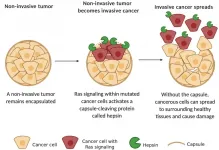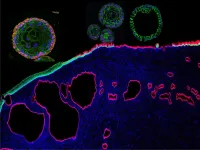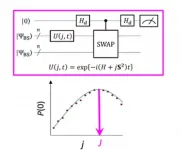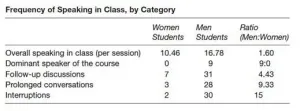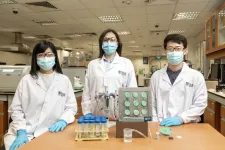(Press-News.org) From a pair of simple principles of evolution--chance mutation and natural selection--nature has constructed an almost unfathomable richness of life around us. Despite our scientific sophistication, human design and engineering have struggled to emulate nature's techniques and her inexhaustible inventiveness. But that may be changing.
In a new perspective article, Stephanie Forrest and Risto Miikkulainen explore a domain known as evolutionary computation (EC), in which aspects of Darwinian evolution are simulated in computer systems.
The study highlights the progress our machines have made in replicating evolutionary processes and what this could mean for engineering design, software refinement, gaming strategy, robotics and even medicine, while fostering a deeper insight into foundational issues in biological evolution.
"With the vast computing resources available today, evolutionary computation is poised to provide the next generation of advances in AI," says Forrest.
Forrest directs of the Biodesign Center for Biocomputing, Security and Society, at Arizona State University. Miikkulainen is from the University of Texas, Austin.
Their research findings appear in the current issue of the journal Nature Machine Intelligence.
The paper focuses on six hallmarks of Darwinian evolution and examines how well digital systems have managed to duplicate these features in order to find solutions to complex problems and generate novel outcomes. These are: openendness, major transitions in organizational structure, neutrality and random drift, multi-objectivity, complex
genotype-to-phenotype mappings, and co-evolution.
Nature as guide
Darwin's remarkable insight reveals how a random iterative process can act on an initial set of conditions to continually improve an organism's fitness--its ability to flourish and reproduce. By implementing these mechanisms, known as evolutionary computation, computer scientists attempt to evolve solutions to various problems over time, through similar processes of mutation and selection, rather than by designing such solutions by hand.
The use of evolutionary computation involves creating an initial population of individuals on a computer, then evolving the population over time, using principles of variation, selection, and inheritance. While the basic idea is simple, the subtleties involved can become dizzyingly complex. Evolutionary computational approaches are also highly versatile, allowing researchers to model biological systems that change with time, such as ecologies or cancer, as well as social systems, including economies or political dynamics.
In principle, virtually any system or technique has the potential for some degree of computer automation, including the design, development and debugging of computer programs, a longstanding goal in computer science.
Calculated creativity
One reason researchers are so excited about borrowing a page from nature's playbook is that the use of evolutionary principles can lead to wildly original solutions that cannot be predicted in advance, allowing computers to make better guesses than their flesh and blood counterparts.
The exciting developments in evolutionary computation are being driven by ever-more-sophisticated algorithms as well as enormous advances computing power, which has increased millions of times over the past 20 years. This has enabled the careful modeling of a broad range of real-world processes, including the simulation and design of new formulas for agricultural growth, smart treatments for injuries and disease and the fine-tuned control of robots and autonomous machines.
Computer-age blueprint
Of the six evolutionary hallmarks highlighted in the study, researchers have made significant inroads in applying several of them. One startling feature of evolution is its openendedness, or ability to advance transformational processes indefinitely, without an established final state. The study cites several examples of artificial life programs that have achieved a measure of openendedness.
Multi-objectivity alludes to the complexity of biological fitness, which results as a consequence of various trade-offs, for example, between resources expended to find food as opposed to attracting mates, producing sufficient offspring and protecting young. Many such features must balance one another to achieve maximum reproductive success. Researchers have recently made progress mimicking multi-objectivity in programs using EC.
Another critical feature of Darwinian evolution that has been modeled in EC systems is co-evolution--the phenomenon of multiple species interacting over the course of evolutionary time, through complex networks of cooperation and competition. Such dynamics have found their way into EC applications including game playing, robot navigation and multi-agent problem solving.
Challenges ahead
Nevertheless, nature keeps some evolutionary cards close to her vest. Certain Darwinian processes have proven more difficult than others to co-opt for problem-solving computer programs. Further, while techniques of evolutionary computation can often mimic processes found in nature, there are also significant differences. Unlike Darwinian evolution among living species, EC tends to operate by applying strong selection pressure to small populations, where more neutral processes such as genetic drift are suppressed.
Further, in nature, the genetic template from which the final organismic form or phenotype will emerge is much more flexible and subject to embryological and epigenetic modifications, allowing for more creative and unpredictable outcomes. Researchers would like to improve this genotype-to-phenotype mapping, incorporating rich environmental interactions to better approximate nature's profound ability to generate novelty.
Finally, evolution's most impressive feat remains too poorly understood to be replicated by computer, namely the ability to achieve major organizational transitions. Here, Darwinian processes can act over time to yield convulsive and unforeseen alterations in structure, for example, the progression from self-replicating molecules to membrane-bound cells, multicellular organisms, advanced social structures and societies with language and culture. Much more work is needed to ferret out the details of nature's organizational transitions.
Nevertheless, the startling advances in evolutionary computation are likely to play a guiding role in the development of machine creativity, drive innovations in engineering and hopefully, elucidate some of the many mysteries still remaining in the study of evolution.
INFORMATION:
Written by: Richard Harth
Senior Science Writer: The Biodesign Institute at ASU
richard.harth@asu.edu
Using cutting-edge DNA sequencing technologies, a group of laboratories in Konstanz, Würzburg, Hamburg and Vienna, led by evolutionary biologist Professor Axel Meyer from the University of Konstanz, succeeded in fully sequencing the genome of the Australian lungfish. The genome, with a total size of more than 43 billion DNA building blocks, is nearly 14 times larger than that of humans and the largest animal genome sequenced to date. Its analysis provides valuable insights into the genetic and developmental evolutionary innovations that made it possible for fish to colonize land. The findings, published online in the journal Nature, expand our understanding of this major evolutionary ...
Researchers at the University of Helsinki have defined a cancer invasion machinery, which is orchestrated by a frequently mutated cancer gene called Ras. When signaling from Ras protein becomes abnormally high, like it does in many cancers, this switches on the cellular machinery that helps the cancer cells to depart from the tissue from which the cells have developed.
It has been unclear how the cancer invasion machinery works exactly, until now, as the study finds Ras in the role of Friar Lawrence in Shakespeare's famous play, "Get me an iron crow and bring it straight unto my cell (Romeo and Juliet, 5.2.21-23)." ...
Climate change is more pronounced in the Arctic than anywhere else on the planet, raising concerns about the ability of wildlife to cope with the new conditions. A new study shows that rare insects are declining, suggesting that climatic changes may favour common species.
As part of a new volume of studies on the global insect decline, researchers are presenting the first Arctic insect population trends from a 24-year monitoring record of standardized insect abundance data from North-East Greenland.
The work took place during 1996-2018 as part of the ecosystem-based monitoring program Greenland Ecosystem Monitoring at the field station Zackenberg, located in the world's largest national ...
Organoids are increasingly being used in biomedical research. These are organ-like structures created in the laboratory that are only a few millimetres in size. Organoids can be used to study life processes and the effect of drugs. Because they closely resemble real organs, they offer several advantages over other cell cultures.
Now there are also organoid models developed for the cervix. This part of the female body is particularly at risk to develop cancers. By creating novel organoid models, a group led by Cindrilla Chumduri (Würzburg), Rajendra Kumar Gurumurthy (Berlin) and Thomas F. Meyer ...
WHAT:
Healthcare providers must be able to explain the latest data supporting the safety and efficacy of vaccines for coronavirus disease 2019 (COVID-19) so they can strongly encourage vaccination when appropriate while acknowledging that uncertainty and unknowns remain. This message comes from a new commentary co-authored by Anthony S. Fauci, M.D., director of the National Institute of Allergy and Infectious Diseases (NIAID), part of the National Institutes of Health, and other leading NIAID scientists in the journal Annals of Internal Medicine.
The commentary provides an overview of the seven COVID-19 vaccines furthest along in development in the United States. For each vaccine candidate, the authors describe ...
Understanding how the natural world works enables us to mimic it for the benefit of humankind. Think of how much we rely on batteries. At the core is understanding molecular structures and the behavior of electrons within them. Calculating the energy differences between a molecule's electronic ground and excited spin states helps us understand how to better use that molecule in a variety of chemical, biomedical and industrial applications. We have made much progress in molecules with closed-shell systems, in which electrons are paired up and stable. Open-shell systems, on the ...
Men speak 1.6 times more often than women in college classrooms, revealing how gender inequities regarding classroom participation still exist, according to a Dartmouth study. By comparison, women are more hesitant to speak and are more apt to use apologetic language. The findings are published in Gender & Society.
When students didn't have to raise their hands to participate in class, men spoke three times more often than women. "You would think that it would be more equitable for students to not have to raise their hands to speak in class because then anyone could talk ...
RICHLAND, Wash.--E-cigarettes stress and inflame the lungs of rats, compromising important regulatory proteins through exposure, according to research recently published in the journal Redox Biology. The findings, made possible by a biomolecular technique developed by researchers at the U.S. Department of Energy's Pacific Northwest National Laboratory, reveal that vaping induces subtle structural changes in proteins, marking the first time researchers have measured such damage. The results suggest that common compounds in the electronic alternative to conventional cigarettes are not without their own harms.
After exposing rats to e-cigarette vapor for three one-hour sessions ...
Some say future wars will be fought over water, and a billion people around the world are already struggling to find enough water to live.
Now, researchers at the National University of Singapore (NUS) are coming to the rescue. They have created a substance that extracts water from air without any external power source.
In the earth's atmosphere, there is water that can fill almost half a trillion Olympic swimming pools. But it has long been overlooked as a source for potable water.
To extract water from this under utilised source, a team led by Professor Ho Ghim Wei from the NUS Department of Electrical and Computer Engineering created a type of aerogel, a solid material that weighs almost nothing. Under the microscope, it looks like a sponge, but it ...
University of South Australia scientists have developed the world's first test to accurately predict mood disorders in people, based on the levels of a specific protein found in the brain.
Links between low levels of mature brain-derived neurotrophic factor (mBDNF) and depression are well known but, until now, it hasn't been possible to distinguish between the three forms of the BDNF protein in blood samples.
The mature form promotes the growth of neurons and protects the brain, but the other two BDNF forms - its precursor and the prodomain of BDNF - bind to different receptors, causing nerve degeneration ...

